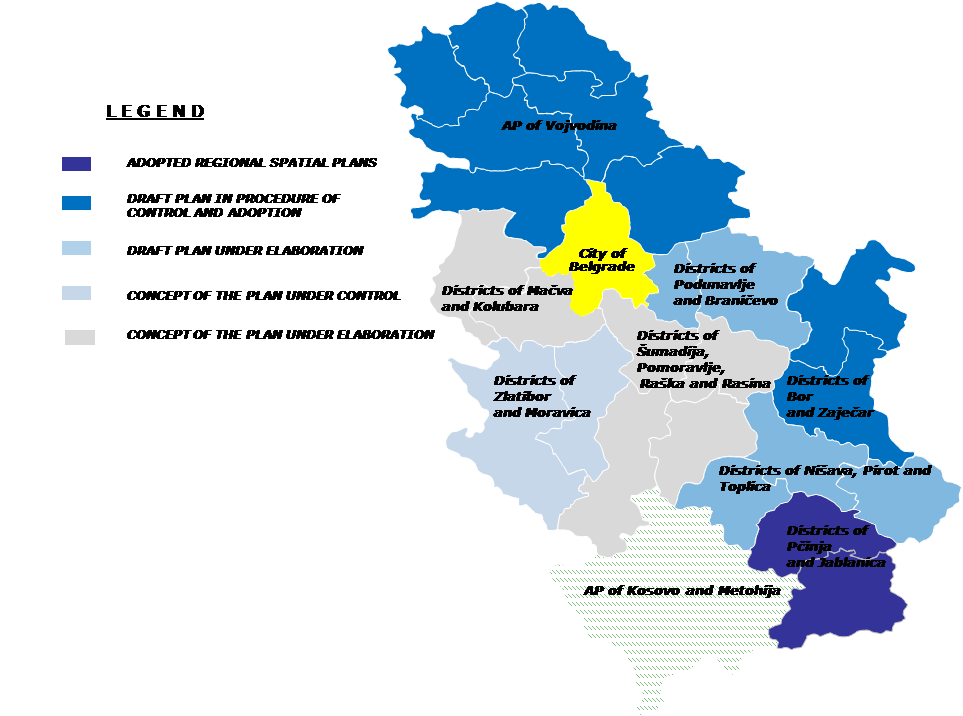Regional spatial plan of the city of Belgrade
After delivering and enacting the Spatial Plan of Serbia the set of regional plans have been started in 2011. Eight of them are being prepared for groups of NUTS3 districts while two of them, for regions NUTS2 with autonomous status: Autonomous Province of Vojvodina and the City of Belgrade. All of the eight plans are coordinated by the Republic Agency for Spatial Planning and two of them (Vojvodina and City of Belgrade) are under provincial and city jurisdiction with their planning offices in charge. The City of Belgrade Town Planning Office engaged the Republic Agency for Spatial Planning for expert support, and Prof.Dr. Borislav Stojkov as general coordinator for the Plan.

Fig 1. Regional Spatial Plans in Serbia
The Regional Spatial Plan of the City of Belgrade is specific for the multiple status of the City, having the status of local community with seventeen city municipalities (according to the Law on Local Self-management), region with NUTS2 and NUTS3 (according to the Law on Regional Development) and statistical NUTS1 status connected with AP Vojvodina. The territory of the City is 3224 km2 with close to 2 million inhabitants, with 7 urban settlements and 138 rural and semi-urban settlements. The future of the City as defined in the Plan was derived from the City of Belgrade Development Strategy also conducted by Prof. Stojkov. The methodology for the Plan, as well as for the Strategy, was integrated model with three basic elements interconnected: environment, economy and social dimension, and the governance as a framework for all three of them.
The analysis of the present state-of-art openly exposed all the strengths and weaknesses of the City’s structure and functions, with opportunities and possible obstacles for the future. Based on this the vision with five goals was offered and adopted with some modulations by all stakeholders. The vision is oriented towards increasing the rank of the City from MEGA4 level today to MEGA3 level until 2020, according to European measures and standards. Out of this several principles were defined: sustainability, competitiveness, territorial cohesion, policenricity, accessibility and identity. Five goals are following these principles and relates to: (a) sustainable activating the territorial capital of the City, (b) increasing the level of accessibility by developing and modernizing the transport and traffic system, (c) enhancing the development balance between more and less developed parts of the City, (d) promotion and sustainable use of natural and cultural heritage and landscape, and (e) modernizing and advancing the governance of the City with its regional surroundings.
The City of Belgrade is enlightened in the Plan with several ideas for the future:
- • The City of Belgrade as one of significant regions and metropolises of Europe
- • The region directed to the synergy of activities
- • The region with higher level of territorial cohesion with important role of its 7 urban centers
- • The city with different identities of its geographic wholes
- • The region functionally integrated with its surroundings in Serbia (special links with the City of Novi Sad) and Europe.
With a set of Plan’s directives and propounds, and especially with a set of strategic priorities to be realized until 2015, the Regional Spatial Plan for the City of Belgrade, has been passed to the City Assembly after successful public and professional hearings.

Fig 2. Regional Spatial Plan of the City of Belgrade - Functional links of the Belgrade Region